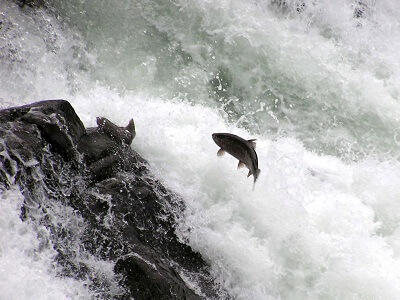In the lower Columbia region, steelhead, chum, chinook, coho and bull trout are listed as threatened under the Endangered Species Act. The federal law requires Clark County and other jurisdictions to ensure their actions don’t jeopardize the survival of these fish. Failure to take appropriate actions could results in fines or lawsuits.
Salmon are declining
Wild fish populations have been greatly diminished by pollution, urban growth, dams, logging, over-fishing, and agriculture. These activities degrade aquatic habitat and make fish more vulnerable to predators by increasing soil erosion, reducing woody debris in streams, raising water temperatures, decreasing stream flows, adding contaminants to our waters and creating passage barriers.
County efforts
Clark County promotes healthier rivers, lakes and streams through many diverse projects and programs.
Stormwater improvements – The county reduces the harmful effects of polluted storm runoff by controlling peak flows during storms, preventing pollution from entering waterways, upgrading facilities, collecting and treating stormwater, and planting trees.
Fish barrier removal projects – Working with local partners, the county identifies and removes culverts that serve as fish barriers.
Erosion control – The county ensures compliance with development regulations to reduce erosion and protect waterways. If you see erosion, please contact our enforcement team.
Limited chemical spraying – The county minimizes use of pesticides, herbicides and other chemicals in managing parks and other public areas.
Conservation properties – The county acquires land to conserve critical habitat and other ecologically sensitive areas.
Regional planning
The county participates in regional planning and recovery efforts. The county serves on the Lower Columbia Fish Recovery Board and helps the Department of Ecology develop Washington RCO Salmon Recovery Information in the Lewis and Salmon/Washougal Water Resources Inventory Areas. Local agencies meet on a regular basis to review the results of the various monitoring and implementation projects in these watersheds.
Regional planning allows for broader funding options for key projects, including seeking grant funding.
State wide efforts
Learn more about salmon protection across the state and read the governor's report here.
